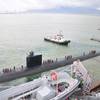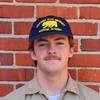Members from the San Diego-based Unmanned Vehicles Detachment (UMV) embarked aboard the 310-ft. MV Kellie Chouest, a research and salvage vessel, April 25 to recover an F-14D Tomcat that had recently crashed in the waters off of San Diego. The Tomcat was from Fighter Squadron (VF) 31, based at Naval Air Station Oceana, Va. The two crew members of the aircraft ejected safely before the crash and sustained minor injuries. They were on a training mission from the Nimitz-class carrier USS John C. Stennis (CVN 74), homeported in San Diego.
According to Lt. Cmdr. Chuck McGuire, the officer in charge (OIC) of UMV, the recovery was scheduled to take a week to complete. The unit's highly sophisticated unmanned vehicles were designed to help speed up the under-water search and recovery.
"We're using the TUWVS [Tethered Unmanned Work Vehicle System] Super Scorpio. It is the same type of vehicle that was used on the Titanic," McGuire said. "An operator can use the arms of the TUWVS to maneuver and lift debris up to 500 pounds. The debris will be placed on the deck of the ship and then transferred for investigation."
"Recovering a 47,000-pound airplane is very costly. It would cost the Navy more than $250,000 to recover the aircraft using divers, cranes and special ships," McGuire said. “We have everything (the Navy) needs to recover the airplane and we can do it at about one third the price." Members of the detachment have demonstrated their ability to assist in major salvage operations in the past. In addition to other recoveries, such as downed submarines and several helicopters, UMV assisted in the recovery of Alaska Airlines Flight 261, which crashed off the coast of California Jan. 31, 2000.
"It actually feels good to know that the Navy is counting on us to get the job done. An investigation about the F-14 has to be completed, and we are helping in that process by recovering the aircraft," Fields added.
In recent years, the remote vehicles from UMV have been responsible for the recovery of more than $100 million worth of military and civilian hardware. UMV remains a flexible and potent asset, always continuing to evolve as new technology and equipment become available.
(By Journalist Seaman Cynthia R. Smith, Navy Public Affairs Center, San Diego)
Featured videos

Inside the Electrified Truckable Tug

Inmarsat Enhances Service to Drive Digitalization

Tracking Foreign Vessels Working in the U.S. Jones Act Market
Subscribe for
Maritime Reporter E-News
Maritime Reporter E-News is the maritime industry's largest circulation and most authoritative ENews Service, delivered to your Email five times per week









